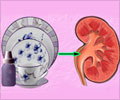Consistently maintaining certain blood levels of markers of bone metabolism and disease can prolong the lives of patients on hemodialysis.
Consistently maintaining certain blood levels of markers of bone metabolism and disease can prolong the lives of patients on hemodialysis, according to a study. The findings indicate that keeping parathyroid hormone, calcium, and phosphorous levels in control is critically important for dialysis patients with chronic kidney disease (CKD).
Because mineral and bone disorder affects most patients with CKD, the National Kidney Foundation Kidney Disease Outcomes Quality Initiative (KDOQI) has set specific treatment targets for the indicators of this disorder—serum levels of parathyroid hormone, calcium, and phosphorous. While research has shown that elevations in these markers are associated with increased morbidity and mortality in dialysis patients, no study has investigated the long-term control of these parameters.Dr. Mark Danese of Outcomes Insights, Inc. (Newbury Park, CA), and his colleagues, Dr. Vasily Belozeroff and Dr. Karen Smirnakis of Amgen, Inc. (Thousand Oaks, CA) and Dr. Kenneth Rothman of Research Triangle Institute (Research Triangle Park, NC), set out to determine whether more consistent control of parathyroid, calcium, and phosphorous levels within the KDOQI target ranges is associated with improved survival. The study was conducted among 24,803 adults initiating dialysis between 2000 and 2002. The researchers assessed whether survival was improved when patients were within the three target levels simultaneously. They also examined whether survival was improved when patients were within each of the three target levels for prolonged periods of time.
The researchers reported that it was important to meet as many of the targets as possible at any given time. Meeting the target for none of the three markers was associated with a 51% higher risk of death compared with patients who achieved targets simultaneously for all three markers. Patients meeting only one target had a 35% to 39% increased risk of death, and patients meeting any two targets had a 15% to 21% higher risk of death.
Dr. Danese and his team also found that the longer an individual met one or more targets, the better. For each marker, patients who achieved target values for less than three months had the highest risk of death compared with those who did so for one year. Compared with patients whose individual target levels were maintained for one year, patients with a parathyroid in target for less than three months had a 34% higher risk of death, patients with calcium in target for less than three months had a 16% higher risk of death, and patients with phosphorous in target for less than three months had a 62% higher risk of death.
The study also revealed that prior to the introduction of the KDOQI guidelines, relatively few patients either simultaneously met the targets for parathyroid hormone, calcium, and phosphorous or met any target for a full year. The authors discovered that levels of these parameters outside the KDOQI target ranges may account for as much as 20% of deaths in dialysis patients.
“These results suggest that there is a need for more consistent achievement of the KDOQI mineral metabolism targets, and that meeting this need may result in improved survival for incident hemodialysis patients,” the authors write. They note that this can be a challenge, however, because the use of current treatment options often requires a tradeoff between controlling parathyroid hormone and controlling calcium and phosphorous.
Advertisement
SRM












